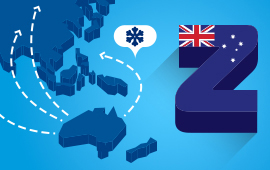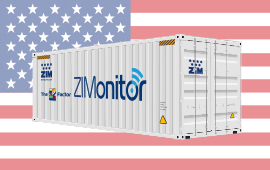Rethinking Fresh: Cold Chain Innovations
Whether it’s life-sustaining medicines that must be kept at a safe temperature or the food we put in our fridge, the cold chain is a key component in the system that protects shipments from harm and delivers to the final customers what they expect.
While some commodities are transported without risk when kept at temperatures you may find in your home kitchen fridge, for others, a few degrees can make all the difference between a successful journey and an accidental spoilage. Most refrigerated products that travel thousands of miles across the globe count on special technology to maintain their quality from door to door.
With the help of Boris Liobine – ZIM Reefers Section Manager, who oversees the technical aspect of ZIM’s reefer fleet, we’ve compiled the key components of driving a safe and reliable global cold chain.
Equipment construction and management
The lifespan of a reefer container ranges between 10-15 years, depending on its level of usage and conditions it has been exposed to. Boris explains that new construction is very common in this sector, especially as new, innovative technologies hit the market.
For reefers, modern construction is even more essential to uphold the fleet’s young age profile. ZIM maintains the youngest reefer fleet in the industry, with an average of about 4 years, while our advanced reefers featuring ZIMonitor capabilities don’t exceed 2 years.
This is especially critical in cases of power outages, leaks, or even during land transportation, when electricity is nowhere to be found: “The newer the container, the more it is able to maintain its temperature, and this is exactly what we offer our customers – a smarter, stronger, and more reliable reefer, one that is resistant to any environmental extreme.”
Product supervision in cold chain facilities
During the construction stage of the reefer, which could take months, it is crucial to monitor and oversee its development. Apart from having regular visits and performing audit operations, we make it a top priority to have an inspector present at the construction sites, factories, and local and global depots during every step of the process, sending daily reports to monitor every activity taking place.
Once the reefer container becomes operational and joins the fleet, whenever it unloads at its destination, it enters a container terminal for a routine checkup where a visual and physical inspection is properly performed, making sure it meets the ZIM standards, which guarantees it is qualified to safely transport the next shipment.
So, where do we go from here?
As ZIM grows its reefer fleet and expands their advanced capabilities, we are constantly looking for new trends and innovations to utilize: “It is very important to us, to be ahead of the curve and introduce cutting-edge technologies to best serve our customers and their cargo.”





